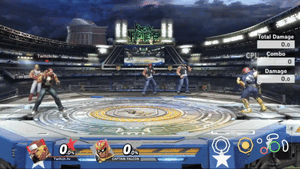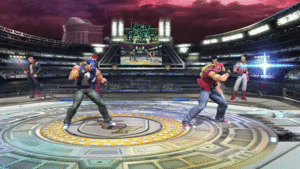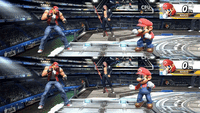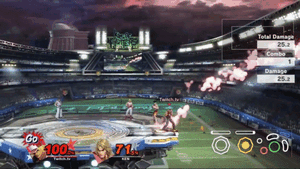Command-input move: Difference between revisions
No edit summary |
m (missing spaces in the command inputs of Rising Tackle) |
||
| Line 32: | Line 32: | ||
*[[Power Dunk]]: A jumping knee strike, and the [[down special]] of {{SSBU|Terry}}. The command version can be accessed by moving towards the opponent, the tilting the control stick down and forward in a "Z" motion, then pressing a button (→ ↓ ↘ + attack/special). If done correctly, Power Dunk will be more powerful, grant intangibility during its ascent, and enable the last hit to [[meteor smash]] during its later frames. | *[[Power Dunk]]: A jumping knee strike, and the [[down special]] of {{SSBU|Terry}}. The command version can be accessed by moving towards the opponent, the tilting the control stick down and forward in a "Z" motion, then pressing a button (→ ↓ ↘ + attack/special). If done correctly, Power Dunk will be more powerful, grant intangibility during its ascent, and enable the last hit to [[meteor smash]] during its later frames. | ||
*[[Rising Tackle]]: An upward corkscrew flying kick, and the [[up special]] of {{SSBU|Terry}}. The command version can be accessed by holding down to charge the attack for a minimum of 24 frames, then quickly pushing up on the control stick and pressing a button (hold ↓ for 24 frames, then ↑+attack/special). This type of input is know colloquially as a "charge motion." If done correctly, Rising Tackle will be more powerful, hit more times, and grant full body [[intangibility]] from frame 5. | *[[Rising Tackle]]: An upward corkscrew flying kick, and the [[up special]] of {{SSBU|Terry}}. The command version can be accessed by holding down to charge the attack for a minimum of 24 frames, then quickly pushing up on the control stick and pressing a button (hold ↓ for 24 frames, then ↑ + attack/special). This type of input is know colloquially as a "charge motion." If done correctly, Rising Tackle will be more powerful, hit more times, and grant full body [[intangibility]] from frame 5. | ||
*[[Power Geyser]]: A [[Super Special Move]] exclusive to {{SSBU|Terry}} after he reaches 100% (or after he reaches below 30 HP in [[Stamina]] battles). This move can be accessed by performing a quarter-circle in one direction, then quickly tilting the control stick in the other direction (↓ ↙ ← ↙ → + attack/special). This input is colloquially known as the "Pretzel Motion" due to its knot-like appearance. A simplified version of this input is also available (↓ ← ↓ → + attack/special). If done correctly, Terry will punch the ground and a massive geyser of energy will explode in front of him, dealing incredibly high damage at the cost of slow startup and high ending lag. | *[[Power Geyser]]: A [[Super Special Move]] exclusive to {{SSBU|Terry}} after he reaches 100% (or after he reaches below 30 HP in [[Stamina]] battles). This move can be accessed by performing a quarter-circle in one direction, then quickly tilting the control stick in the other direction (↓ ↙ ← ↙ → + attack/special). This input is colloquially known as the "Pretzel Motion" due to its knot-like appearance. A simplified version of this input is also available (↓ ← ↓ → + attack/special). If done correctly, Terry will punch the ground and a massive geyser of energy will explode in front of him, dealing incredibly high damage at the cost of slow startup and high ending lag. | ||
Revision as of 07:17, April 2, 2021
Command Input Special Moves, also known as Command Attacks, are upgraded versions of the special moves of Ryu, Ken, and Terry that requires a specific motion on the control stick and a button press in a specific window of time.
Overview
In traditional fighting games, a "command input" is typically defined as any combination of a direction and/or button press that causes a move to be executed. In the Super Smash Bros. series, it is used for attacks that require more input than a simple direction + button press, typically those that require directional inputs on the control stick prior to executing the attack. In Ultimate, taunt inputs can be used instead of the control stick.
While most command input special moves can be activated by simply pressing the B button and holding a direction, they are intentionally made slower and weaker to reward players for using the inputs instead. Command versions of these moves are more complicated to activate, but have the benefit of being faster, more powerful, and sometimes have added effects.
There are also some moves that can only be activated via command input, such as Shakunetsu Hadoken, which are often integral to their respective character's gameplay. These moves are often at their most useful during combos, with Ken using his for combo purposes, enabling numerous kill confirms. With the addition of Terry in Ultimate, some command input special moves can also be "unlocked" when reaching a certain damage threshold, known as Super Special Moves. These moves often have far more complex inputs, but deal extremely high damage and knockback, making usage extremely rewarding.
There are also some advanced techniques that can be utilized with command inputs, such as charge partitioning, and Kara Canceling.
Moves with Command Inputs
- Hadoken: A blue single-hit energy projectile, and the neutral special of Ryu and Ken. The command version can be accessed by rotating the control stick a quarter-circle toward the opponent, then pressing a button (↓ ↘ → + attack/special). If done correctly, the Hadoken will deal more damage, and the user will announce the move's name in a fiercer tone. If Kirby copies Ryu or Ken's neutral special, he can perform the command-input version of the move.
- Tatsumaki Senpukyaku: an airborne spinning crescent kick, and the side special of Ryu and Ken. The command version can be accessed by rotating the control stick a quarter-circle away from the opponent, then pressing a button (↓ ↙ ← + attack/special). If done correctly, Tatsumaki Senpukyaku will be more powerful. Ryu will announce the move's name ("Tatsumaki Senpukyaku!" while grounded, "Tatsumaki!" while airborne) instead of grunting, whereas Ken will merely announce the move's name in a fiercer tone.
- Shoryuken: A leaping uppercut, and the up special of Ryu and Ken. The command version can be accessed by moving toward the opponent, the tilting the control stick down and forward in a "Z" motion, then pressing a button (→ ↓ ↘ + attack/special). If done correctly, Shoryuken will be more powerful while having more intangibility (frames 1-14 versus frame 5) and lower landing lag (16 frames versus 23 frames).
- Shakunetsu Hadoken: A special variant of the Hadoken, exclusive to Ryu. This move can be accessed by rotating the control stick a half-circle toward the opponent, then pressing a button (← ↙ ↓ ↘ → + attack/special). If done correctly, a red, multi-hit Hadoken which uses the flame effect will come out; it has more combo utility and hitstun than the average Hadoken. If Kirby copies Ryu's neutral special, he can perform this move using the command input.
- Oosoto Mawashi Geri: An outward roundhouse kick that is exclusive to Ken. This move can be accessed by rotating the control stick a half-circle toward the opponent, then pressing the attack button (← ↙ ↓ ↘ → + attack/special). If the button is held, Ken will perform an Inazuma Kick, which is similar to his far-range held neutral attack and deals an impressive amount of shield damage.
- Nata Otoshi Geri: A swiping crescent kick that is exclusive to Ken. This move can be accessed by performing a reversed quarter circle motion toward the opponent, then pressing a button (→ ↘ ↓ + attack/special). If the button is held, Ken will perform an Inazuma Kick, which is similar to his far-range held neutral attack and deals an impressive amount of shield damage.
- Burning Knuckle: A lunging energy punch, and the forward-side special of Terry. The command version can be accessed by rotating the control stick a quarter-circle toward the opponent, then pressing a button (↓ ↘ → + attack/special). If done correctly, the Burning Knuckle will be more powerful and will grant intangibility to Terry's attacking arm, with a green-yellow trail behind him. It should be noted that the input is reversed from his home series, as it is normally a quarter-circle away from the opponent.
- Crack Shoot: A spinning heel kick, and the back-side special of Terry. The command version can be accessed by rotating the control stick a quarter-circle away from the opponent (↓ ↙ ← + attack/special). If done correctly, the move will deal more damage in general, and the second hit of Crack Shoot will deal drastically increased shield damage, with the tipper hitbox dealing an additional 20 HP of damage. This makes it excellent at breaking shields.
- Power Dunk: A jumping knee strike, and the down special of Terry. The command version can be accessed by moving towards the opponent, the tilting the control stick down and forward in a "Z" motion, then pressing a button (→ ↓ ↘ + attack/special). If done correctly, Power Dunk will be more powerful, grant intangibility during its ascent, and enable the last hit to meteor smash during its later frames.
- Rising Tackle: An upward corkscrew flying kick, and the up special of Terry. The command version can be accessed by holding down to charge the attack for a minimum of 24 frames, then quickly pushing up on the control stick and pressing a button (hold ↓ for 24 frames, then ↑ + attack/special). This type of input is know colloquially as a "charge motion." If done correctly, Rising Tackle will be more powerful, hit more times, and grant full body intangibility from frame 5.
- Power Geyser: A Super Special Move exclusive to Terry after he reaches 100% (or after he reaches below 30 HP in Stamina battles). This move can be accessed by performing a quarter-circle in one direction, then quickly tilting the control stick in the other direction (↓ ↙ ← ↙ → + attack/special). This input is colloquially known as the "Pretzel Motion" due to its knot-like appearance. A simplified version of this input is also available (↓ ← ↓ → + attack/special). If done correctly, Terry will punch the ground and a massive geyser of energy will explode in front of him, dealing incredibly high damage at the cost of slow startup and high ending lag.
- Buster Wolf: A Super Special Move exclusive to Terry after he reaches 100% (or after he reaches below 30 HP in Stamina battles). This move can be accessed by performing two quarter-circle motions towards the opponent (↓ ↘ → ↓ ↘ → + attack/special). A simplified version of this input is also available (↓ → ↓ → + attack/special). If done correctly, Terry will launch forward. If Terry connects with the opponent, they will be grabbed and thrown for incredibly high damage, similarly to the close-range grab hitbox of Lucario's Force Palm. Unlike force palm, there is only a grab hitbox, meaning Buster Wolf is extremely punishable if it fails to connect. The move is also a hit grab, much like Isabelle's Fishing Rod, meaning that opponents can effortlessly shield the move and punish it out of shield.
Negative Edge
Negative edge is a mechanic involving any command input special move, which is present in traditional fighting games. To perform, hold the attack or special-move button during an attack, input the special move, and release said button shortly after the attack is over. Essentially, pressing and releasing an attack button can be treated as a half-A press in the context of a command special move. This will always be treated as a tap input, so only the weakest variations of the special moves will occur. This is not to be confused with buffering, which is where a player holds a button to perform an action on the first possible frame. Negative edge is present in SSB4 and Ultimate.
Negative edge primarily exists to make combos with special moves easier for players to perform, making it a good technique for new players to utilize when starting out. For example, with Ryu, it is possible to use negative edge to make canceling his close strong neutral attack into Shoryuken easier. However, as aforementioned, this can only result in a weak Shoryuken. As such, learning the inputs without negative edge is important in order to get full use out of the characters.
Due to negative edge only resulting in weak inputs, it tends to only be optimal in cases where the weak input is necessary. This best applies to situations such as Terry's neutral aerial into Burning Knuckle, which can otherwise be difficult to recover from using off-stage. Additionally, at higher percentages, the strong version can sometimes be too slow to connect reliably. For a more niche case, against characters like Mega Man, Robin, and Ken, there are situations where Terry's up tilt can be canceled into a weak Crack Shoot and result in a dragdown; normally at around 75%. Negative edge can be used to consistently get the weaker version, reducing the chance of human error.
Tiger Knee

Tiger Knee is an advanced technique exclusive to Ultimate that involves making use of the a full hop alongside command inputs. The name comes from similar motions in traditional fighting games. While this can be applied to any command special that can be used in the air, it is only viable with Terry, due to Ryu and Ken's special moves manipulating their gravity (e.g. Hadoken) or being too committal (e.g. Shoryuken). To perform the technique, input a jump alongside a singular A or B press prior to inputting a command special. Due to requiring a jump prior to the final input, it cannot be used alongside a special cancel.
If performed correctly, a jump will occur at the same time as the special move. This has various applications, such as autocanceling Power Dunk[1], getting a higher arc with Crack Shoot, and using Burning Knuckle's aerial variation closer to the ground, allowing it to drift past the ledge. An autocanceled Power Dunk using this technique is even on shield, enabling Terry to mix up with moves like neutral attack. Additionally, it acts as a somewhat committal way to get past projectiles, which can also be applied to Tiger Knee Crack Shoot. Tiger Knee Burning Knuckle allows Terry to get around the grounded version locking him to the ledge, boosting its potential threat range on-stage and making Terry's edgeguarding much less committal.
Renda Canceling
Renda canceling, sometimes known as "Chain canceling" in some fighting game circles, is an advanced technique introduced in Ultimate. This technique consists of inputting part of a command special, using a move through the c-stick, and subsequently finishing the input. For example, with Terry, one can input ↓ ↘ →, down tilt using the c-stick, then ↓ ↘ → + attack/special, and still get Buster Wolf.
This technique is essential for Terry in particular, because it allows his Super Special Moves to connect much more consistently without the need to drop hit advantage for the inputs. Being able to save frames adds a lot of consistency to Power Geyser and Buster Wolf, and since only part of the commands needs to be inputted before the attack connects, this gives the Terry player a lot more control; if the move does not connect or does not give a favorable situation for the special, the player should simply not finish the input. Buster Wolf's input also allows for Burning Knuckle to be used instead should the situation call for it. Overall, Renda canceling is an essential part of Terry's kit.
Command Orientation Input Locking
Command orientation input locking (often abbreviated as COIL, sometimes known as COIL charging) is an advanced technique introduced in Super Smash Bros. Ultimate.[2][3] It involves exploiting a quirk in the way the game reads controller inputs to technically be moving in two directions at the same time. Before performing this technique, the player needs to ensure that their C-Stick is set to tilt attacks instead of smash attacks. First, the player needs to hold the control stick in a certain direction, then hold the C-Stick in the same direction. Then, the player needs to let go of the control stick while still holding the C-Stick. For example, if the technique is done correctly and both sticks are held down followed by the control stick being released, the C-Stick will trick the game into think the control stick is still down. While COIL is technically performable with every fighter, it is only truly useful for Ryu, Ken and Terry, where the first input of a command input or charge motion is available to them at all times, making said inputs easier to perform. Terry especially benefits from this technique by being able to run up to an opponent and perform an invincible Rising Tackle without holding down for 24 frames. The only disadvantage to COIL is that the attack button ceases to function while the C-Stick is held, making normal attacks unusable.
A variant of this move called Double Tap Command Orientation Input Locking (DTCOIL) has a slightly different activation method. After holding down on the analog stick, the player should quickly tilt the C-Stick twice, making sure that only one tilt attack comes out. Two tilt attacks means the activation did not work. Then continue the technique as normal. If done correctly, the direction will still be charged and the A button will function, circumventing the issue with normal COIL.
Origin
Command inputs can be traced back to the 1987 arcade game Street Fighter. In that game, the player can access the Hadoken, Tatsumaki Senpukyaku, and Shoryuken with their respective inputs. There was a very strict window to activate, but all moves did massive amounts of damage to compensate. Players complained that the activation window was too strict which led to inputs being "eaten" and the controls feeling inconsistent. Capcom listened to these complaints and decided to make special moves easier to perform at the cost of damage for Street Fighter II. Takashi Nishiyama, creator of Street Fighter, also listened to these complaints after moving to SNK and created Fatal Fury. These two games laid the foundation for all fighting games in the future, and the inputs introduced are now commonplace across the genre.
Negative Edge is primarily seen in traditional fighting games, particularly Street Fighter. The term "negative" refers to the use of a depressed button, and for this reason, it sometimes goes by names such as "Button Up". Since its inception, games like Marvel vs. Capcom and BlazBlue adopted it for accessibility purposes. However, this feature is also seen in games like Super Mario 64, designed to make its different jumps easier to perform in sequence. In Super Mario 64 circles, it is referred to as a "half-A press" and utilized for challenge runs.
Tiger Knee got its name from Sagat's "Tiger Knee" (↓ ↘ → + ↗ + Kick) in Street Fighter II, which involves using a jump input (↗) to perform. As is in Ultimate, it is performed by using the command on the ground and doing the final input when airborne. While Sagat himself had no use for the technique, the input itself later became useful in other fighting games—particularly Guilty Gear—allowing for aerial versions of moves to be used extremely close to the ground. Because of this, moves utilized through this bypass are referred to as being "Tiger Kneed".
Renda canceling is a technique featured in Street Fighter II[4], working almost identically to how it does in Ultimate. However, only "rapid fire" weak attacks can be renda cancelled. Because the window for supers in Street Fighter II are so small, renda canceling is often considered to be required learning to play the iterations with supers properly. It is sometimes referred to as Chain canceling.


